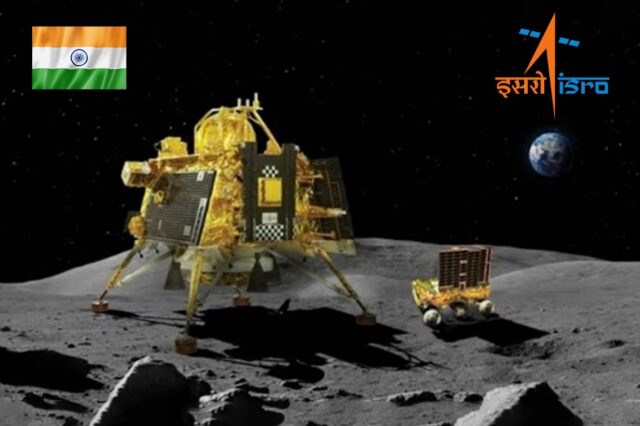India has achieved a monumental milestone in space exploration, becoming the first country to successfully land a spacecraft near the south pole of the moon. The historic moment was met with jubilation across the nation as citizens gathered at watching parties to witness this groundbreaking achievement. At approximately 6:00 PM local time (12:30 BST), cheers erupted as the Vikram lander, a component of the Chandrayaan-3 spacecraft developed by the Indian Space Research Organisation (ISRO), touched down near the uncharted lunar south pole. Sreedhara Panicker Somanath, the chair of ISRO, exclaimed, “India is on the moon,” capturing the essence of the momentous accomplishment. This achievement not only solidifies India’s position as a formidable player in space exploration but also underscores the nation’s commitment to fostering private space endeavours and satellite-based businesses.
The landing site chosen for this historic feat holds immense scientific promise. The lunar south pole is believed to harbour vital reserves of frozen water and precious elements, making it a focal point for future space missions and potential colonization efforts. The successful landing paves the way for further exploration of these resources that could shape the future of space travel and human presence on other celestial bodies.
The event captivated the nation, with people from all walks of life glued to their television screens as the spacecraft embarked on its daring descent. The Prime Minister of India, Narendra Modi, described the achievement as a “victory cry of a new India” and waved the Indian flag in celebration while observing the landing from South Africa, where he was attending the Brics summit. He emphasized the historic nature of the event, declaring, “We are witnessing history.” In the lead-up to the touchdown, a wave of nervous excitement swept across India. Temples and mosques conducted special prayers for the safe landing of the spacecraft. In Varanasi, alongside the sacred Ganges River, Hindu monks imparted blessings upon the mission, blowing conch shells to invoke auspiciousness. Street parties erupted throughout the country as the nation celebrated the dual achievement of being the first to land near the moon’s south pole and the fourth to successfully land on the moon overall.
The final moments leading up to the touchdown involved a complex manoeuvre executed by the lander. Gradually decelerating from a staggering speed of 3,730 miles per hour to nearly zero, the lander transitioned from a horizontal to a vertical position. The precise balance of tilt and thrust was crucial to prevent mishaps. Too much force could result in toppling, while too little could lead to an undesired landing site. This final maneuver had been a challenge in India’s previous moon mission in 2019, underscoring the significance of this successful landing. The Chandrayaan-3 mission, translating to “moon craft” in Sanskrit, lifted off from Sriharikota, India’s spaceport, on July 14. In contrast to the Apollo missions of the 1960s and 70s, which reached the moon within days, India’s approach involved multiple Earth orbits to gain speed before embarking on its month-long journey to the moon. Should all proceed according to plan, the Pragyaan rover – meaning “wisdom” in Sanskrit – will soon disembark from the lander and explore the moon’s surface for a span of two weeks. The rover is equipped to capture images, conduct geological experiments, study Earth’s origins, and investigate the presence of water ice. The discovery of substantial water ice reserves could prove pivotal for future crewed missions, as it could potentially serve as a source of oxygen and fuel. The moon’s south pole, with its unique geography, has been identified as a promising site for future lunar bases.
India’s triumph comes on the heels of Russia’s recent setback, where its lunar mission targeting the south pole ended in failure. The accomplishment further solidifies India’s presence on the global space exploration stage, a status aligned with its emergence as the world’s fifth-largest economy. As India celebrates this momentous achievement, the eyes of the world are on its burgeoning space program. The successful landing not only signifies a significant scientific advancement but also highlights India’s determination to push the boundaries of human exploration and its unwavering commitment to innovation on a global scale.









